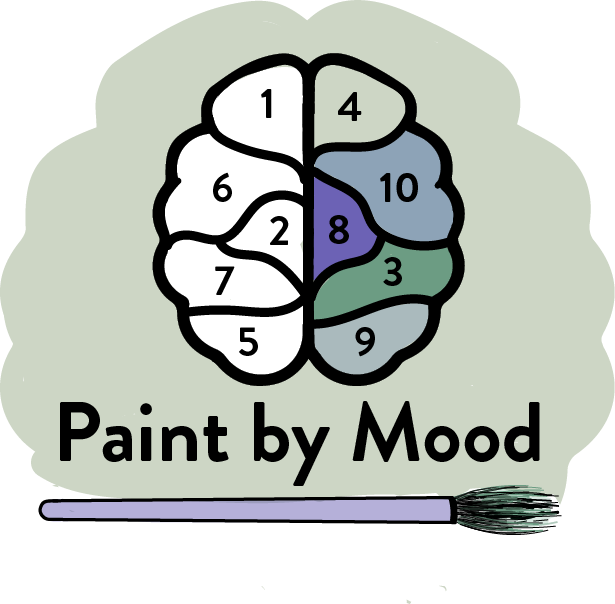
Paint by Mood is a meditative website that aims to quickly improve your mood by generating an interactive surprise paint by number, playing music and displaying a quote, all correlating to how you’re feeling. We all experience negative mood states, but how we respond to those emotions is different for all of us. If we don’t practice emotion regulation or prioritize improving our mood state then that can lead to more serious mental health issues down the line. The art, music, quotes, and colors chosen for this website were based on scientific research with the goal to improve your mood. Click a category below to learn more!
Art is often used as a tool to improve mental health; the results of this study[1] show that engaging with art is mentally beneficial and effective. There was a different study[2] conducted on university students, they were divided into three different coloring groups. Results showed that students who were given a pre-drawn design had more significant reductions in anxiety, depression and tension. For this reason, I wanted to focus on creating paint by numbers. When designing the paint by numbers, I opted for geometric shapes, abstract patterns, nature, landscapes and animals. This study[3] explains the physiological benefits of looking at nature, especially fractal patterns. As for animals, research[4] shows that they increase serotonin ("happy hormone") levels in our brain.
1. Jensen A, Bonde L.The use of arts interventions for mental health and wellbeing in health settings.Perspectives in Public Health. 2018;138(4):209-214.doi:10.1177/1757913918772602
2. Drake, Crystal R., H. Russell Searight, and Kristina Olson-Pupek. The Influence of Art-Making on Negative Mood States in University Students. American Journal of Applied Psychology 2.3 (2014): 69-72.
3. Hagerhall CM, Laike T, Küller M, Marcheschi E, Boydston C, Taylor RP. Human physiological benefits of viewing nature: EEG responses to exact and statistical fractal patterns. Nonlinear Dynamics Psychol Life Sci. 2015 Jan;19(1):1-12. PMID: 25575556.
4. Wells, D.L. (2009), The Effects of Animals on Human Health and Well‐Being. Journal of Social Issues, 65: 523-543. https://doi.org/10.1111/j.1540-4560.2009.01612.x
Color psychology[1] explains how colors influence our mind and emotions. For example, the color red raises your pulse rate and stimulates your mind. The color yellow is associated with laughter, happiness and optimism. Green, purple, and blue are often used for relaxation which makes them ideal for reducing stress. Pink also has a calming effect, this was observed when a prison painted their walls pink and it resulted in a reduction of violent behavior[2]. The main color of this website is green. The reason for this is because green is the easiest color for our retina to see and therefore there is less strain on our eyes[3].
1. Cherry, K. (2020, May 28). Can color affect your mood and behavior? https://www.verywellmind.com/color-psychology-2795824#the-psychological-effects-of-color
2. Bakhshi S, Gilbert E. Red, purple and pink: The colors of diffusion on Pinterest. PLoS One. 2015;10(2):e0117148. doi:10.1371/journal.pone.0117148
3.Jimison, A., Mayani, R. (2017, June 05). Why we all need green in our lives. https://www.cnn.com/2017/06/05/health/colorscope-green-environment-calm/index.html
The mental health benefits of listening to music are evident in the correlation between music and mood. A study[1] was done on the psychological functions of music testing, and the responses from 183 individuals revealed that “People today hardly listen to music for social reasons, but instead use it principally to relieve boredom, maintain a pleasant mood, and create a comfortable private space”. I then researched what type of genres help with sadness, anger, stress, and boredom. Most people tend to listen to sad music when they are sad, but that doesn't necessarily mean they will feel happy afterwards. A study[2] revealed this when the results showed "Both ruminators and non-ruminators experienced similar increases in Depression scores after listening to sad music". I then decided to gather happy ambient, pop, and classical music for the sad playlist. I found an article[3] which explains that "Listening to music can have a tremendously relaxing effect on our minds and bodies, especially slow, quiet classical music". This is due to the music's ability to slow down your heart rate and lower your stress hormones. Similar to feeling sad, many people tend to listen to angry music when they are angry. However, that tends to only be effective for people who prefer that type of music. A study[4] showed that listening to classical or calming music is more effective in reducing anger and anxiety. Therefore I opted for slow, ambient and classical music for the stressed and angry playlists. As for boredom, a there is a study[5] that explains how listening to music can improve efficiency and foster creativity. For the feeling bored playlist I gathered a mix of genres labeled as inspirational.
1. Schäfer T, Sedlmeier P, Städtler C, Huron D. The psychological functions of music listening. Front Psychol. 2013;4:511. Published 2013 Aug 13. doi:10.3389/fpsyg.2013.00511
2. Garrido S, Schubert E. Moody melodies: Do they cheer us up? A study of the effect of sad music on mood. Psychology of Music. 2015;43(2):244-261. doi:10.1177/0305735613501938
3.Collingwood, J. (2016, May 17). The power of music to reduce stress. https://psychcentral.com/lib/the-power-of-music-to-reduce-stress#1
4.Sharman, L., Dingle, G. A. (2015). Extreme metal music and anger processing. Frontiers in Human Neuroscience, 9. doi:10.3389/fnhum.2015.00272
5.Lesiuk, T. (2005). The effect of music listening on work performance. Psychology of Music, 33(2), 173-191. doi:10.1177/0305735605050650
The use of motivational or inspiring quotes has been a very popularized practice. I found an article[1] that examines the correlation between mental health and motivational quotes. Gathered from various clinical and educational settings, motivational quotes have been observed as "...effectively increasing confidence, motivation, empowerment, and satisfaction in adults struggling with stress, anxiety, depression, mental illness, and substance abuse”.
1.Bedrov, Alisa, and Grzegorz Bulaj. Improving Self-Esteem With Motivational Quotes: Opportunities for Digital Health Technologies for People With Chronic Disorders. Frontiers in psychology vol. 9 2126. 2 Nov. 2018, doi:10.3389/fpsyg.2018.02126 (Czuchry and Dansereau, 2005; Kendall et al., 2005; Brann and Sloop, 2006; Marchinko and Clarke, 2011; Littlechild et al., 2013; Poon, 2016)